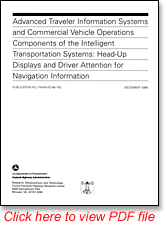Advanced Traveler Information Systems and Commercial Vehicle Operations Components of the Intelligent Transportation Systems: Head-Up Displays and Driver Attention for Navigation Information
Development Of Human Factors Guidelines For
Advanced Traveler Information Systems And
Commercial Vehicle Operations
Head-Up Displays And Driver Attention
For Navigation Information
FOREWORD
This report is one of a series reports produced as part of a contract designed to develop precise, detailed human factors design guidelines for Advanced Traveler Information Systems (ATIS) and Commercial Vehicle Operations (CVO). The contractual effort consists of three phases: analytic, empirical, and integration. This report is a product of the empirical phase. The empirical phase will also address topics such as: ATIS function transition, display channels, multi-modality displays, CVO driver fatigue, display formats and workload, and head-up displays (HUDs). Among the analytic topics discussed in the series are functional description of ATIS/CVO, comparable systems analysis, task analysis of ATIS/CVO functions, alternate systems analysis, identification and exploration of driver acceptance, and definition and prioritization of research studies.
This report documents a study that was performed to determine the effects of an automotive HUD when used to present route guidance information.
Copies of this report can be obtained through the Research and Technology Report Center, 9701 Philadelphia Court, Unit Q, Lanham, Maryland 20706, telephone: (301) 577-0818, fax: (301) 577-1421, or the National Technical Information Service (NTIS), 5285 Port Royal Road, Springfield, Virginia 22161, telephone: (703) 487-4650, fax: (703) 321-8547.
Michael F. Trentacoste
Director, Office of Safety
Research and Development

PDF Version (231 KB)
PDF files can be viewed with the Acrobat® Reader®
TECHNICAL REPORT DOCUMENTATION PAGE
| 1. Report No. FHWA-RD-96-153 |
2. Government Accession No. |
3. Recipient's Catalog No. |
| 4. Title and Subtitle
Advanced Traveler Information Systems And Commercial Vehicle Operations Components Of The Intelligent Transportation Systems: Head-Up Displays And
Driver Attention For Navigation Information
|
5. Report Date March 6, 1998 |
| |
6. Performing Organization Code |
| 7. Author(s) B. L. Hooey & B. F. Gore |
8. Performing Organization Report No. |
| 9. Performing Organization Name and Address Battelle Human Factors Transportation Center
4000 NE 41st Street
P.O. Box 5395
Seattle, WA 98105-0395
|
10. Work Unit No. (TRAIS) 3B2C1012 |
| |
11. Contract or Grant No. DTFH61-92-C-00102 |
| 12. Sponsoring Agency Name and Address Office of Safety and Traffic Operations R&D
Federal Highway Administration
6300 Georgetown Pike
McLean, VA 22101-2296
|
13. Type of Report and Period Covered
Technical Report
April 1, 1997 – March 15, 1998
|
| |
14. Sponsoring Agency Code |
| 15. Supplementary Notes Contracting Officer's Technical Representative (COTR): M. Joseph Moyer, HRDS; Thomas M. Granda,
HRDS (formerly with SAIC)
|
| 16. Abstract
Since the initial development of prototype automotive head-up displays (HUDs), there has been a concern that the presence of the HUD image may interfere
with the driving task and negatively impact driving performance. The overall goal of this experiment was to examine the driving performance implications
of an automotive HUD when used to present simple route guidance information. Of particular importance was how navigation aids (head-down display [HDD] vs.
HUD) and drivers' age interact to influence driver behavior. Twenty-four younger and older subjects participated in the study, which was conducted in the
Battelle High-Fidelity Driving Simulator. Each subject drove three experimental scenarios--two urban and one rural. During the scenarios, subjects were
required to adhere to posted speed limits and remain within their lane boundaries. They were also required to respond, as quickly as possible, to
emergency incidents such as balls rolling into the road, a car crossing against a red light immediately in front of them, and a car in front of them
suddenly braking to a stop. This study revealed no differences with respect to navigation performance, response to unexpected events, or driving
performance as a function of navigation aid. Nonetheless, while performance (considered overall) was not better in the HUD condition than in the HDD
condition, neither was the HUD associated with performance decrements. In particular, none of the results suggest that the HUD was a distraction to
the subjects or that it was associated with any form of cognitive capture.
|
| 17. Key Words
Human Factors, Automotive Head-Up Displays (HUDs), Advanced Traveler Information Systems (ATIS), Driver Attention, Navigation Messages
|
18. Distribution Statement No restrictions. This document is available to the public through the National Technical
Information Service, Springfield, Virginia, 22161.
|
| 19. Security Classif. (of this report) Unclassified |
20. Security Classif. (of this page) Unclassified |
21. No. of Pages 60 |
22. Price |
Form DOT F 1700.7 (8-72) Reproduction of completed page authorized
FHWA-RD-96-153
|
